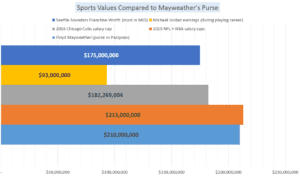Friday Fights: The Economics of MMA
In this week’s Friday Fights, Adam takes a look at how MMA fighters’ contracts are structured and how they are paid. It may surprise you to learn these fighters’ realities when compared to other athletes in America.


The logo for the weekly column Friday Fights.
A widely known piece of information is the massive amount of money involved in professional sports in the United States. Some may agree or disagree with how much they are being paid, but what is indisputable is that professional athletes make quite a bit of money in this country.
Aaron Rodgers, of the Green Bay Packers, will make about $43,850,000 in base salary over the next four seasons. Mike Conley, of the Memphis Grizzlies, will make approximately $152,605,576 over the next five years. Mike Trout, of the Los Angeles Angels of Anaheim, will make around $134,250,000 over the same period of time. And those aren’t even the craziest numbers.
Floyd Mayweather, retired boxer, is perhaps the best example of the money that is tied up in professional athletics. In his last fight, against Andre Berto in September of 2015, Mayweather made a guaranteed purse of $32 million. In his primetime showdown against Manny Pacquiao on May 2nd of last year, Mayweather made $210 million. The man made 210 MILLION DOLLARS for one boxing match that lasted just 36 minutes. $210 million is larger than the 2016 team salary cap for the Chicago Cubs. It trails the combined 2015 salary caps of the NFL and NBA by just $3 million. Mayweather’s pay equates to approximately $97, 222.22 per second. It’s insane to even attempt to comprehend those numbers and how a single man was able to make that much for a single fight.


As shown in the very simple graph I have created, Floyd Mayweather made more money on May 2, 2015 than Michael Jordan made in his entire playing career. The fighter also made enough to outright purchase the Seattle Sounders, the most valuable franchise in Major League Soccer.
But wait, if Mayweather makes that sort of absurd money, what do MMA fighters make? It has to be similar, right? Well, not exactly. And by not exactly, I mean not even close.
In fact, when compared to any other professional sport in the United States, MMA fighters make quite a bit less. It is difficult to truly assess the pay and contractual details of MMA fighters, particularly UFC fighters, because the promotions are privately owned and therefore not required to disclose athlete compensation. There are a handful of states that require the base pay to be released, but that number doesn’t include things such as performance bonuses, pay-per-view bonuses, pay-per-view shares and more.
However, in the past few years, more details have been discovered regarding the pay of MMA fighters. In 2013, thanks to current UFC Lightweight champion Eddie Alvarez, we learned a bit more on how fighter contracts and their payouts are structured.
At the time, Alvarez was a fighter for Bellator, UFC’s primary competition, and he was testing the free-agent market. While the battle was going on between Bellator and UFC to sign him, Alvarez publicized a lot of information regarding his contract − information that would otherwise not be known. Part of the information that he released, was how he was being paid based on pay-per-view buys.
For those who don’t already know how MMA compensation functions, here’s a quick crash-course. There is base pay, or a “disclosed purse”, which is simply the guaranteed amount of money a fighter will be paid for fighting. Then there are performance bonuses, such as Fight of the Night, Knock-out of the Night, Submission of the Night, etc. These bonuses can range in dollar amount, but in the UFC they are worth $50,000. And then, there are cuts of the pay-per-view buys. Only established, valuable fighters receive these. A set dollar amount will be agreed upon in the fighter’s contract that determines what they will be paid per the number of pay-per-view buys.
The way the UFC handles these cuts of pay-per-view purchases was revealed by Alvarez when he publicly discussed his negotiations with UFC back in late 2012 and early 2013.
UFC wanted to sign him away from Bellator, so they tried to elevate their offer to a point that their competitor could not possibly match. They offered Alvarez a co-main event spot on UFC 158, which featured Georges St-Pierre (an all-time great in MMA) in the main event. On top of this, Alvarez revealed what the promotion offered him per number of pay-per-view buys.
Per Yahoo! Sports, UFC offered Alvarez one dollar for every buy between 200,000 and 400,000 buys. That rate would increase to two dollars for every buy between 400,000 and 600,000 buys. And it would increase further to $2.50 for every buy over 600,000.
According to an ESPN article published in 2014, the deal was for eight fights, including a base salary of $70,000, a $70,000 win bonus (that increased by $5,000 each time he won a fight) and a $250,000 signing bonus.
Although Alvarez agreed to the deal, he was not allowed to begin fighting under the UFC promotion yet. Bellator matched the deal and Alvarez was forced to return to its cage, rather than the UFC’s.
Fast-forward to mid-2014 and Alvarez was finally allowed to leave Bellator. Afterwards, he agreed to a deal with the UFC almost instantly. Although he never disclosed the specifics to this deal, Alvarez did say to ESPN.com in the same article, “It’s comparable (to the 2012) deal – it’s better. Let’s just say that I’m pleased.”
What can be assumed from that statement is that he was at least offered the same deal as was offered in 2012, with the potential that it was even better. It obviously pleased Alvarez.
But it shouldn’t have.
Let’s break this down for a moment. Assume that a fighter agreed to the deal reportedly offered sometime in 2012, and that their first fight was a win on pay-per-view. That would mean they would have made $70,000 in base pay and $70,000 for a win bonus. Let’s say the specific pay-per-view event they fought in was bought 750,000 times. That would mean they’d make $975,000 in a pay-per-view bonus. Which would bring the grand total of that single fight to $1,115,000 (excluding any performance bonuses).
At first glance that seems pretty great — I’d love to be paid over a million dollars for only 15 minutes of work. However, when compared to other professional athletes’ contracts, it doesn’t stack up.
The problem was that the UFC only offered those pay-per-view bonuses for Alvarez’s first fight. After that, he would no longer receive them. That would leave him with just $140,000 for a win, instead of over a million.
Remember how Aaron Rodgers’ base salary over the next four years is $43,850,000? Well if you were to spread that out evenly over 16 regular season games for four seasons (64 games), that comes out to approximately $685,000 per game. That means Rodgers is guaranteed to make, at a minimum, nearly $700,000 per regular season game. That does not include signing bonuses, performance bonuses, sponsorships or playoff games.
Alvarez’s deal doesn’t look so great comparatively, does it?
Every other major sport in the United States has an official body that protects the athletes from not only physical damage, but also from being taken advantage of by the leagues and promotions they compete in. MMA however, does not have one, and it shows.
In other sports, player unions have made sure that if players get injured and cannot compete, they are still guaranteed a certain amount of their pay. Those unions ensure that the athletes’ rights and liberties are not being infringed upon by the contracts they sign.
MMA does not have any such official body. There is no fighter’s union protecting the livelihoods of the fighters, and there are no legal regulations keeping the promotions in check. In the current status quo, fighters have only themselves to rely on in negotiations with promotions, which does not end well for the fighters most of the time.
Another factor to keep in mind is that Alvarez is an elite-level fighter — he was arguably the hottest fighter on the free-agent market when the UFC and Bellator were competing to sign him. With Rodgers being widely considered the best quarterback in the NFL, and Alvarez being the champion of his division in the UFC, the two men are on a similar level in their respective sports. However, per competition, Rodgers makes 10 times what Alvarez brings in.
That difference is huge, much larger than anyone would expect. And the difference is even more noticeable in the lower-tier performers.
The NFL’s minimum salary for a year is $435,000. Remember that number.
Aljamain Sterling is a bright, young star in the UFC, unquestionably one of the best the promotion has in its bantamweight division. Back on May 29th of this year, he suffered his first loss as a professional MMA fighter. He only earned $30,000 for his efforts. Even if he had won, he would have just made $30,000 more, bringing his total pay for a win to less than Alvarez’s base pay. Sterling is one of the best fighters in the promotion, ranked No. 7 in the official bantamweight rankings. The young fighter re-negotiated his contract at the beginning of 2016 while still undefeated, and he’s still only getting paid a $30,000 base pay per fight.
Let’s assume Sterling won every fight he competes in from here on out. That would mean he’d be making $60,000 per win. Do you know how many times he would have to fight in a calendar year to surpass the NFL minimum salary per season?
Eight, Sterling would have to fight, and win, eight times to surpass the $435,000 minimum salary in the NFL. On average, fighters are only able to fight between two and three times per year, and on rare occasions they can fight up to four. Even if Sterling fought four times in a year, he would still make considerably less than the NFL minimum. And he is one of the best and most promising fighters in UFC. Can you imagine what a lower-level, unheard of fighter is being paid?
What about fighters in other promotions — promotions that can’t come close to the amount of money the UFC wields?
MMA is a rapidly-growing sport, and as a MMA fan, it is wonderful to see more and more people become fans. However, there are still many issues the sport must resolve before it can ever truly become a mainstream sport in the United States.
Treatment of fighters, specifically fighter compensation, is one of those issues. Some may disagree with the absurd amounts that professional athletes are paid in this country, and that viewpoint is completely okay to have. But, it isn’t going to change. And if other sports are already paying astronomical amounts to their athletes, there is one vital question to ask.
Why not MMA fighters?
Edited by Dalton King
Featured image by Adam Milliken
Adam is the Assistant Sports Editor for the Tennessee Journalist and a Junior at UT. Most of his free time is spent watching sports, listening to good music, and enjoying life. If you wish to contact him, you can email him at amillike@vols.utk.edu, follow him on Twitter, @AdamMilliken14, or find him at https://www.linkedin.com/pub/adam-milliken/109/a89/a32.



